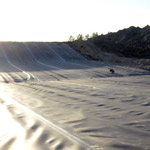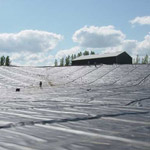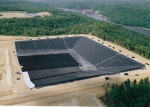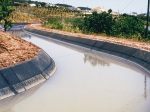Primary Functions Of Geosynthetics
Geosynthetics are generally designed for a particular application by considering the primary function that can be provided. As seen in the accompanying table there are five primary functions given, but some groups suggest even more.
 Separation is the placement of a flexible geosynthetic material, like a porous geotextile, between dissimilar materials so that the integrity and functioning of both materials can remain intact or even be improved. Paved roads, unpaved roads, and railroad bases are common applications. Also, the use of thick nonwoven geotextiles for cushioning and protection of geomembranes is in this category. In addition, for most applications of geofoam, separation is the major function.
Separation is the placement of a flexible geosynthetic material, like a porous geotextile, between dissimilar materials so that the integrity and functioning of both materials can remain intact or even be improved. Paved roads, unpaved roads, and railroad bases are common applications. Also, the use of thick nonwoven geotextiles for cushioning and protection of geomembranes is in this category. In addition, for most applications of geofoam, separation is the major function.
Reinforcement is the synergistic improvement of a total system’s strength created by the introduction of a geotextile, geogrid or geocell (all of which are good in tension) into a soil (that is good in compression, but poor in tension) or other disjointed and separated material. Applications of this function are in mechanically stabilized and retained earth walls and steep soil slopes; they can be combined with masonry facings to create vertical retaining walls. Also involved is the application of basal reinforcement over soft soils and over deep foundations for embankments and heavy surface loadings. Stiff polymer geogrids and geocells do not have to be held in tension to provide soil reinforcement, unlike geotextiles. Stiff 2D geogrid and 3D geocells interlock with the aggregate particles and the reinforcement mechanism is one of confinement of the aggregate. The resulting mechanically stabilized aggregate layer exhibits improved load bearing performance. Stiff polymer geogrids, with rectangular or triangular apertures, in addition to three-dimensional geocells made from new polymeric alloys are also increasingly specified in unpaved and paved roadways, load platforms and railway ballast, where the improved load bearing characteristics significantly reduce the requirements for high quality, imported aggregate fills, thus reducing the carbon footprint of the construction.
Filtration is the equilibrium soil-to-geotextile interaction that allows for adequate liquid flow without soil loss, across the plane of the geotextile over a service lifetime compatible with the application under consideration. Filtration applications are highway underdrain systems, retaining wall drainage, landfill leachate collection systems, as silt fences and curtains, and as flexible forms for bags, tubes and containers.
Drainage is the equilibrium soil-to-geosynthetic system that allows for adequate liquid flow without soil loss, within the plane of the geosynthetic over a service lifetime compatible with the application under consideration. Geopipe highlights this function, and also geonets, geocomposites and (to a lesser extent) geotextiles. Drainage applications for these different geosynthetics are retaining walls, sport fields, dams, canals, reservoirs, and capillary breaks. Also to be noted is that sheet, edge and wick drains are geocomposites used for various soil and rock drainage situations.
Containment involves geomembranes, geosynthetic clay liners, or some geocomposites which function as liquid or gas barriers. Landfill liners and covers make critical use of these geosynthetics. All hydraulic applications (tunnels, dams, canals, reservoir liners, and floating covers) use these geosynthetics as well.


















